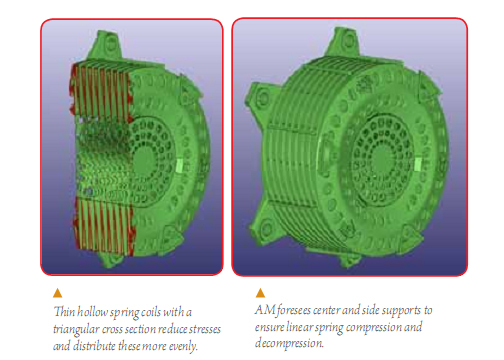3D Printed Spring Exceeds Traditional Manufacturing

TNO and LayerWise 3D printed spring. Courtesy of LayerWise
Latest News
April 12, 2012
I’ve talked to a number of people in the additive manufacturing (AM) industry who don’t believe the technology is ready to take over more traditional methods of mass production. This is probably true is most cases, particularly where parts are just stamped out by the dozen. Not every part that’s made for consumer use is produced in large batches, however, opening the door for improvements on design offered by AM.
LayerWise and TNO have teamed up recently to produce an end-use part through AM. In the course of developing an actuator for high accuracy positioning, TNO found it required a specific type of spring. The original prototype spring was created from machined high tensile steel.
“Although the spring stiffness is sufficient for its specific purpose in the actuator assembly, the spring’s internal stresses rose as high as 1200 MPa, said John Van der Werff, mechanical designer for TNO’s rapid manufacturing department. “TNO engineers collaborated with LayerWise to re-think the spring design with AM in mind, and explored what weight and performance gains were within reach.”
Working with STL files provided by TNO, LayerWise was able to create titanium springs using laser sintering. Titanium is lighter than steel, and the alloy selected (TiAl6V4) was able to withstand 300 MPa, but that wasn’t quite good enough. Unlike subtractive methods, a single failed prototype isn’t as big a deal with AM. With less time required for a new build, TNO was able to rework the design of the spring.
The new design used springs half the thickness of the first AM prototype, which resulted in nearly halving the internal stresses. TNO then moved to a hollow coil with triangular cross sections that distributes stresses more evenly. These efforts combined to create a spring with stress levels four times lower than the original steel prototype.
“To compensate for the spring’s reduced stiffness, we implemented a design comprising of eight identical parallel spring coils. This had no impact on production cost because AM produces the entire spring, including all spring coils, as a single part in one production step,” said Van der Werff. “The Titanium spring part incorporating perforated top and bottom disks with eight thin hollow spring coils in between enabled us to cut spring weight 70%. Such impressive results underline AM’s superior lightweight design capabilities.”
The spring created by TNO and LayerWise demonstrates the advantage AM has over subtractive methods in variable-density construction of parts. While it is unlikely whole factories will be given over to rows of 3D printers for mass manufacturing, some parts can simply not be made affordably through traditional manufacturing methods.
Below you’ll find a video about LayerWise.
Source: LayerWise
Subscribe to our FREE magazine, FREE email newsletters or both!
Latest News
About the Author
John NewmanJohn Newman is a Digital Engineering contributor who focuses on 3D printing. Contact him via [email protected] and read his posts on Rapid Ready Technology.
Follow DE






